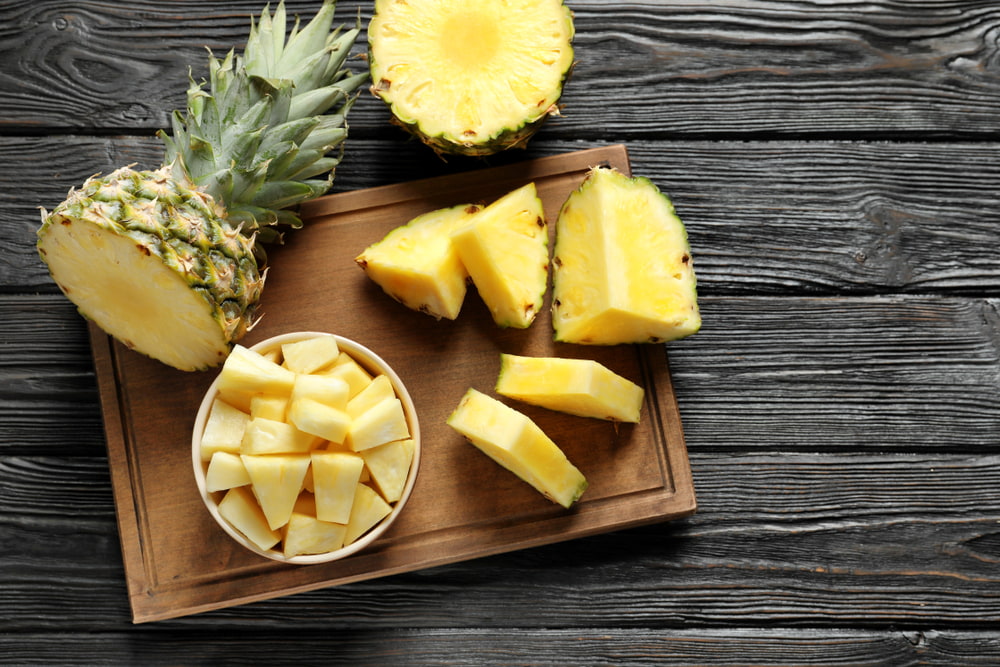Can Dogs Eat Pineapple?

Pineapple, that delicious tropical fruit with an iconic appearance, actually did not originate in Hawaii. Instead, it actually comes from South America. Early european explorers, including Christopher Columbus, were captivated by this unique fruit and helped to spread it throughout the world [1].
As we enjoy a delicious bowl of pineapple or eat a slice of pineapple upsidedown cake we may be tempted to share this fruit with our dogs. But as responsible pet parents we know it’s important to do a bit of research first.
So is pineapple okay for dogs? Is it safe to feed our pups these juicy fruits? Continue reading to learn how to feed your dog pineapple and discover some benefits and downsides to offering your canine companion this food.
Can Dogs Eat Pineapple?
While pineapple is not commonly fed to dogs (after all—coring a pineapple is a bit of a pain), it is not toxic to them. And pineapple may even carry some canine health benefits.
Pineapples are packed with healthy nutrients including fiber, vitamin C, vitamin B-6 and magnesium. Fiber plays an important role in healthy digestion and works to keep the gut microbiome—beneficial organisms in the digestive tract—healthy. The vitamin C in pineapples helps to support healthy immune function and is an antioxidant, working to protect the body’s cells from damage.
Pineapples also contain an enzyme called bromelain. This enzyme helps to break down proteins so it too can benefit digestion. Bromelain’s protein-digesting action is what creates that tingling sensation in your mouth when you eat pineapple. Bromelain is also thought to decrease inflammation in the body and studies suggest a benefit to giving this enzyme to people with arthritis [2]. In addition, some research studies in mice have shown that bromelain also has some anti-cancer properties [3].
Another possible benefit of feeding dogs pineapple is that it may help to stop dogs from eating their poop, also known as coprophagia. There are no controlled studies to prove this but it is a remedy touted by many veterinarians and pet parents. The theory behind why this may help is that the bromelain in pineapple will increase how much of a dog’s food is digested, thus making their poop less enticing.
Can Dogs Eat Fresh Pineapple?

Fresh pineapple can be fed to dogs in small quantities. When pet parents are giving their dogs any unfamiliar foods, it is always a good idea to only give a very small quantity to begin with. That is because dogs with certain food sensitivities or sensitive stomachs, may react poorly to some foods.
Fresh pineapple is very high in vitamin C, which makes it pretty acidic and this acidity may not be well tolerated by some dogs and may cause gastrointestinal upset like vomiting or diarrhea. The acidity of pineapple can also damage a dog’s tooth enamel. Feeding a dog fresh pineapple will also increase their fiber intake and giving too much fiber can lead to diarrhea.
Pineapple is also fairly high in natural sugar. High sugar intake in dogs as in humans can cause weight gain, aggravate diabetes, and cause stomach upset.
With that being said, if your dog likes pineapple and doesn’t have any stomach issues from feeding it, fresh pineapple is ok to give in small quantities as an occasional treat. Treats should never make up more than 10 percent of your dog’s daily caloric intake.
Can Dogs Eat Canned Pineapple?

Feeding dogs canned pineapple is generally not recommended. Some canned pineapple may come in syrup which contains high amounts of added sugars. Even pineapple that is packed in 100 percent pineapple juice will still contain higher sugar content and calories per serving than fresh pineapple. Canning pineapple also causes this food to lose some of its beneficial nutritional value.
Can Dogs Eat Dried Pineapple?

Dried pineapple typically contains added sugars so those varieties definitely should not be fed to dogs. However, even the unsweetened variety isn’t a great snack option for your pup. When fruit is dried, the sugars in the fruit become very concentrated and dried pineapple will contain at least three times as much sugar than the same weight of fresh pineapple. This also increases the calorie content per serving.
Pineapple Cores and Dogs: What to Watch For
The center of pineapples contains a tough fibrous core. It’s the part that most people eat around and discard when eating fresh sliced pineapple. Similarly, dogs should not eat pineapple cores.
For one, the core is tough to digest and may cause gastrointestinal upset. Most importantly, if a large chunk of pineapple core is swallowed it could lead to an intestinal blockage, requiring emergency surgery to treat. Dogs should also not be fed the outer spiny peel of pineapples for the same reasons.
Pineapple For Dogs: How To Serve It

If you choose to feed your dog pineapple make sure to only use 100 percent fresh pineapple with no added sugars. As mentioned above, canned pineapple and dried pineapple shouldn’t be given to dogs due to higher sugar and calories.
Remember to give your dog a very small amount as a trial run to make sure it does not cause an upset stomach. Once you have ensured that he is not sensitive to pineapple you can try the following:
Freeze It
Feed a few small frozen chunks for an occasional refreshing treat on a hot summer day. You can buy pineapple pre-frozen to make it easy.
Top Your Dog’s Food
Feed a cored and peeled slice on top of your dog’s food to add some tropical flavor to that kibble.
Use It As a High Value Reward
If you’re working on training, you can use a few small pieces of fresh pineapple as an extra tasty treat for a job well done.
Don’t Overdo Pineapple for Dogs
Just remember when feeding dogs pineapple not to go overboard. An average sized slice of pineapple contains 42 calories [4]. Remember not to feed more than 10 percent of your dog’s daily calories in the form of treats as feeding more will unbalance their diet.
This means that a Chihuahua should have no more than ½ a slice of pineapple per day if that is the only treat he is being fed. Meanwhile, a Great Dane could enjoy a few slices.
If your pet is overweight or obese, make sure you consult with your veterinarian about how many calories per day you should be feeding your dog to help him lose weight.









